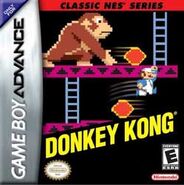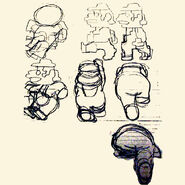| Donkey Kong (game) | |
| Developer(s) | Nintendo |
| Publisher(s) | Nintendo |
| Main Development Staff | {{{devteam}}} |
| Platform(s) | Arcade, NES, Atari 2600 |
| Release Date(s) | Arcade 1981 NES |
| Genre(s) | Platforming |
| Ratings | |
| Mode(s) | Single player, Multiplayer |
| Media(s) | {{{media}}} |
| Input(s) | {{{input}}} |
Donkey Kong was Nintendo's first big hit in America. It also marked the first appearances of Mario (known as Jumpman, a carpenter) and of Donkey Kong. It was released in 1981 & (1983 re-release ).
The game sold well in the United States. It is one of four games to be inducted into the Nintendo Hall of Fame. The original arcade version has four screen levels, but the NES version only has three (50m was cut from this version).
In the Frantic Factory Stage in Donkey Kong 64, Donkey Kong can activate an Arcade machine of the original arcade game. The game is fully playable, and includes all 4 screens, unlike most other ports. After clearing all 4 screens once, Donkey receives a Golden Banana, and can spend 2 Banana Coins to play through the game again to receive a Nintendo Coin. After that, it can be played in full as if you were playing it on an actual arcade machine.
Super Smash Bros. Brawl also has the game Donkey Kong (The NES version) as an unlockable masterpiece. Instead of starting from the beginning stage, players will start at the second stage. To unlock it, the player must play the game for ten hours. There is also an unlockable stage, 75m that is based on the third level of the game.
Story
Mario mistreats his pet gorilla Donkey Kong who grabs Mario's girlfriend Pauline, and runs to the top of a construction site. Mario must climb to the top, save Pauline, and defeat Donkey Kong.
History
Donkey Kong was created when Shigeru Miyamoto was assigned by Nintendo to convert Radar Scope, a poorly selling arcade game in the U.S., into a game that would have more appeal to Americans. The result was a major breakthrough for Nintendo and for the video game industry. Sales of the machine were brisk, with the game becoming the best-selling arcade machine of all time in its era. The gameplay itself was the first of its time. With the growing base of arcades to sell to, the game was able to gain huge distribution. A little well-known fact is that Donkey Kong was the first appearance of Nintendo's world famous Mario character - known as Jumpman in this game. The machine was Nintendo's first worldwide success.
In 1982, Universal Studios sued Nintendo, claiming that Donkey Kong infringed on Universal Studios' intellectual property rights to the film King Kong. Howard Lincoln, attorney and future president of Nintendo of America, decided to fight the case, and hired seasoned attorney John Kirby to represent Nintendo. When Kirby showed that not only was Nintendo not in violation of any copyrights, but also that Universal Studios themselves had sued RKO Pictures in 1975 to prove that the plot of King Kong was in fact in the public domain, Judge Robert W. Sweet ruled in Nintendo's favor, ordering Universal to pay Nintendo $1.8 million in legal fees. In an ironic twist, Judge Sweet also ruled that Tiger's King Kong video game, licensed by Universal, infringed on Donkey Kong. After the victory, Nintendo awarded John Kirby with a $30,000 sailboat, christened the Donkey Kong, and gave him exclusive worldwide rights to use the name for sailboats.
Due to the huge success of Donkey Kong, Nintendo of America was able to grow and release many more games in succeeding years and had the resources necessary to release the Nintendo Entertainment System in the USA.
Enemies
- Donkey Kong
- Normal Barrels - (Can be thrown in any direction)
- Trouble Bugs
- Blue Barrels - (Can only be thrown directly down to the bottom of the stage)
- Trampolines
Gameplay
Donkey Kong is an early example of the platform genre (it is sometimes said to be the first platform game, although it was preceded by Space Panic and Apple Panic). Competitive video gamers and referees stress the game's high level of difficulty compared to other classic arcade games. Winning the game requires patience and the ability to accurately time Jumpman's ascent. In addition to presenting the goal of saving the Lady/Pauline, the game also gives the player a score. Points are awarded for finishing screens; leaping over obstacles; destroying objects with a hammer power-up; collecting items such as hats, parasols, and purses (presumably belonging to Pauline); and completing other tasks. The player receives three lives with a 1-up awarded for the first 7,000 points. The highest recorded score was set by Billy Mitchell on June 26 2007; he achieved 1,050,200 points.
The game is divided into four different one-screen stages. Each represents 25 meters of the structure Donkey Kong has climbed, one stage being 25 meters higher than the previous. The final screen occurs at 100 m. Later ports of the game omit or change the sequence of the screens; the original arcade version includes:
- Screen 1 (25 m)—Jumpman/Mario must scale a seven-story construction site made of crooked girders and ladders while jumping over or hammering barrels and oil barrels tossed by Donkey Kong. The hero must also avoid flaming balls, which generate when an oil barrel collides with an oil drum. Players routinely call this screen "Barrels".
- Screen 2 (50 m)—Jumpman/Mario must climb a five-story structure of conveyor belts, each of which transports pans of cement. The fireballs also make another appearance. This screen is sometimes referred to as the "Factory" or "Pie Factory" due to the resemblance of the cement pans to pies.
- Screen 3 (75 m)—Jumpman/Mario rides up and down elevators while avoiding fireballs and bouncing objects, presumably spring-weights. The bouncing weights (the hero's greatest danger in this screen) emerge on the top level and drop near the rightmost elevator. The screen's common name is "Elevators".
- Screen 4 (100 m)—Jumpman/Mario must remove eight rivets, which support Donkey Kong. The fireballs remain the primary obstacle. Removing the final rivet causes Donkey Kong to fall and the hero to be reunited with the Lady/Pauline. This is the final screen of each level. Players refer to this screen as "Rivets".
These screens combine to form levels, which become progressively harder. For example, Donkey Kong begins to hurl barrels more rapidly and sometimes diagonally, and fireballs get quicker. The victory music alternates between levels 1 and 2. The 22nd level is unofficially known as the kill screen due to an error in the game's programming that kills Jumpman after a few seconds, effectively ending the game. With its four unique levels, Donkey Kong was the most complex video game at the time of its release, and only the second game to feature multiple levels.
Remakes/Ports
Colecovision
Coleco did not offer the game cartridge stand-alone; instead, they bundled it with their ColecoVision. The units went on sale in July 1982. Coleco's version was a more accurate port than earlier games that had been done.
Atari 2600
Donkey Kong was also released on the Atari 2600. It had down-graded graphics and sound, though still had the same gameplay mechanic.
Classic NES Series: Donkey Kong
It was re-released on the Game Boy Advance as a part of Nintendo's "Classic NES Series" remakes of popular NES games. It is a relatively unchanged, faithful port of the original





